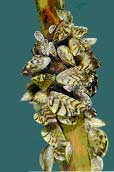FY2006 President's Request
AQUATIC INVASIVE SPECIES INITIATIVE
What is requested?
The National Oceanic and Atmospheric Administration
requests $2.5M for the Aquatic Invasive Species Program to protect the
Nation's aquatic resources from the increasingly costly challenge of invasive
species. The Program is part of a Presidential crosscut budget initiative
involving nine Federal agencies and is a cooperative effort between NOAA
Research, the National Ocean Service, and the National Marine Fisheries
Service. The requested funding will cover monitoring, control, education,
and research mandated by the 1996 National Invasive Species Act to identify
locations where invasive species need to be reduced by early targeted rapid
response and to prevent new introductions.
Why do we need it?
Hundreds of millions of dollars are spent each year
to mitigate the effects of aquatic invasive species in our coastal and Great
Lakes ecosystems. Aquatic invasive species disrupt the stability of coastal
ecosystems, thereby affecting recreational, economic, and other beneficial
uses of coastal resources. They constitute one of the largest present and
future threats to coastal ecosystems, coastal economies, protected habitats,
and human health in coastal regions. As a threat to endangered species, invasive
species are second only to habitat loss, and they have been responsible for
some of the most dramatic fishery losses in recent times (e.g.,
Lake trout, turbot, whitefish, and salmon in Great Lakes). For example, the
cost associated with the invasive zebra mussel introduction is over $200
million each year. The introduced European green crab threatens the vitality
and economic productivity of U.S. marine ecosystems at an estimated cost
of more than $44 million annually from loss of juvenile shellfish and crabs
consumed by the green crab.
The National Invasive Species Act identifies the need
for early detection and monitoring of aquatic invasive species and mandates
that NOAA, in conjunction with other Federal agencies, develop a comprehensive
national program. In addition, the recommendations in the U.S. Commission
on Ocean Policy's 2004 report reaffirm the importance of NOAA's
invasive species programs. It calls for greater coordination among agencies
and adequate funding to carry out invasive species programs.
Reliable and comparable monitoring of coastal ecosystems
based on standardized protocols is essential for the early detection of introduced
species. In addition to enabling a rapid response to new introductions, the
monitoring data will identify factors that facilitate invasions, affect rates
of spread, and influence impacts of invasive species on coastal ecosystems.
Aquatic Invasive Species Initiative At-a-Glance
What: $2.5M Total
Why: To prevent and eradicate aquatic
invasive species and reduce their impacts on our Nation's resources.
Office of Oceanic & Atmospheric Research, Ocean, Coastal and Greal
Lakes Research, Other Partnership Programs
What will we do?
This program focuses on the prevention, control, and
monitoring of invasive species. Control activities include eradication, population
reduction, preventing further spread, and/or mitigating the impact of invasive
species.
Of the requested increase for NOAA's Invasive
Species Program,$1.5M will allow NOAA to: (1) continue to
implement the national program to develop standardized survey methods and
sampling protocols, (2) add another region to the Early Warning System for
Aquatic Invasive Species Introduction, and (3) complete an additional aquatic
species baseline assessment. The remaining $1.0M will be used to enhance
National Marine Fisheries Service activities to control established populations
of invasive species determined to be high priorities. In the following years,
this effort will include research for the development of new control technologies.
In addition, the program will continue be coordinated with efforts in the
Aquatic Nuisance Species Task Force, the National Sea Grant College Program,
other NOAA and federal programs, and the academic community.
What are the benefits?
The Program will respond to legal mandates and the
most urgent national needs related to the growing aquatic invasive species
problem.
Benefits will include:
- Eradication, containment, and/or mitigation of invasive species.
- Development of new control technologies, which will reduce the economic
and environmental costs of highly invasive species.
- Increased ability to detect new aquatic invasive species early enough
to allow targeted rapid response.
- Identification of introduction pathways and development of effective
approaches to reduce invasion risks to NOAA steward resources.
- Verification and availability of more ballast water treatment technologies
and management approaches.
- Reduction or interdiction of other pathways through targeted risk reduction
actions, education, and increased public awareness and participation.
- Increased availability of management information to control invasive
species, such as life history parameters, potential range, and possible
pathways for spread.
- Completion of invasive species baseline assessments and Early Warning
Systems for improved detection of new aquatic invasive species and verification
of potentially invasive species within two weeks of detection.
- Implementation of top priority green crab control measures.
- Working towards completion of the pilot National Early Warning Systems
in FY 2008, using protocols and effectiveness measures developed and proven
in regional pilots.



